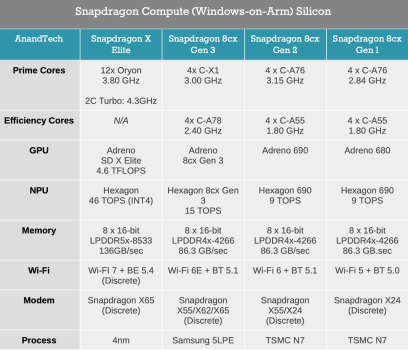That's pretty impressive for a 1st gen product.
Note that the Apple Silicon comparison is a little misleading. It says "matching" uses 30% less power - not beating it.
In the graph, their processor is getting a score of 3,227 which is this universe is a larger number than 2,841. So they are "beating it" . "not beating it" isn't really questionable.
What Qualcomm is saying is that if you just want to get a score of 2,841 ( the lower score) , they can do that at 30% less power than the M2 Max.
From the diagrams is looks like Qualcomm's package will shot past where the Apple packages tend to top on power consumption. Their main competitive is the AMD/Intel which do. So they designed something that ranges out further into the TDP consumption zone than Apple does. But if they choose to 'dial back' to the same constraints as Apple ... they are doing a bit better.
That is somewhat tractable if uses some highly optimized N4P versus Apple's trailing edge N5/N5P of M2. Also Qualcomm likely doesn't have the P-core clusters on as tight a bandwidth consumption limiter as Apple does ( Apple needs to save bandwidth space for their GPU ... which for a M2 Max likely gets better performance. ). Some of this is just design trade offs.
So if they downclock to get a 2800 score, it uses 30% less power than M2 Max. But to get the 3200 score, they might be using 30% more power than M2 Max.
Which is likely not a problem for Windows PC vendors which needs to make laptops which can run in the power consumption zone with AMD/Intel processors. Going to have Windows PC vendors that are likely going to want to build one chassis and throw all three of those SoC variants on slightly different logic boards into it to save on 'overhead'.
The key factor is the M2 Max isn't going to get that 3200 score. You are switching from 'power' to 'score' .
Reportedly Qualcomm is making folks use their power management chips. So if tell the PM chip to hold the SoC at M2 Max power consumption levels then probably have something that is more than competitive on the CPU core performance front. That really isn't a 'problem' for the laptop chassis that are smaller and thinner than Windows PC norms.
Also, they should probably be comparing to M2 Pro - not Max for ST. Oryon looks like an M2 Pro class product, not max. Pro is a bit more efficient than Max.
Not in Windows PC land. The CPU core counts don't go that low ( Intel throws E cores to crank up the count and Qualcomm and countering with P cores at roughly the same count) . And there really isn't a big gap between M2 , M2 Pro , and M2 Max on ST anyway. The Apple stuff is being thrown up in the graphs as a "yeah those guys too" kind of slide.
Oryon isn' going to displace a single Mx SoC in any Mac system. The only place Qualcomm is going to get displacement from the legacy vendors is in the Windows space. So those are the only reasonable norms this are couched toward. At the moment the iGPUs are weaker there and "bigger iGPU" is a more consistent compare.
Qualcomm isn't going to ship soon , so the reality they have to compete with Intel Ultra Core 100's and AMD 8000 laptop offerings over the long term. ( and M3 generation. ).
There's no doubt that Qualcomm wanted to do this press release before M3 otherwise, they'd look stupid comparing it to M2. Like I said, it's impressive for 1st gen though.
Err, that is probably backwards. Decent chance Apple wanted to go after them. They also don't want to go after Intel Ultra 100 (Meteor Lake) and AMD 8000 mobile entries either. They may keep their ST crown but some of the other metrics are going to backslide a bit.
A bulk of my investment portfolio is Apple stocks with a tiny bit of Qualcomm stock. I knew Qualcomm would do fairly well on 1st gen and will likely take share away from AMD and Intel.
Qualcomm hasn't mentioned price. If they charge more than AMD/Intel they will likely take more 'revenue' than 'share' away from those two. The radios ( wifi , BT , Cellluar ) are discrete , but it have to bundle those ( and power management ) to get a decent price on the base SoC the total system costs likely gets pushed up over average PC laptop selling price. Which means relatively fewer units sold.
Apple used their Arm transition to generally push their system unit prices higher. Qualcomm is likely to follow the same path.





